Fifteen percent of agricultural production costs in industrialized agriculture are energy related, according to the U.S. Department of Agriculture (Sands et al., 2011). Even though lighting is an essential part of most farms, only recently has lighting been seen as an opportunity to reduce energy costs. Energy-efficient lighting options offer poultry growers new opportunities to reduce electricity costs and manage operations more sustainably. In the past decade, the poultry industry has migrated from incandescent to compact fluorescents (CFLs) to cold cathode lamps and finally has appeared to settle on light emitting diode (LED) technology as the best option from an energy efficiency standpoint.
Light sources – benefits and shortcomings
While LEDs appear to be the lighting technology now and for the future, various other options exist and are regularly used. Hy-Line International (2017) offered the following information on various light sources.
Sunlight
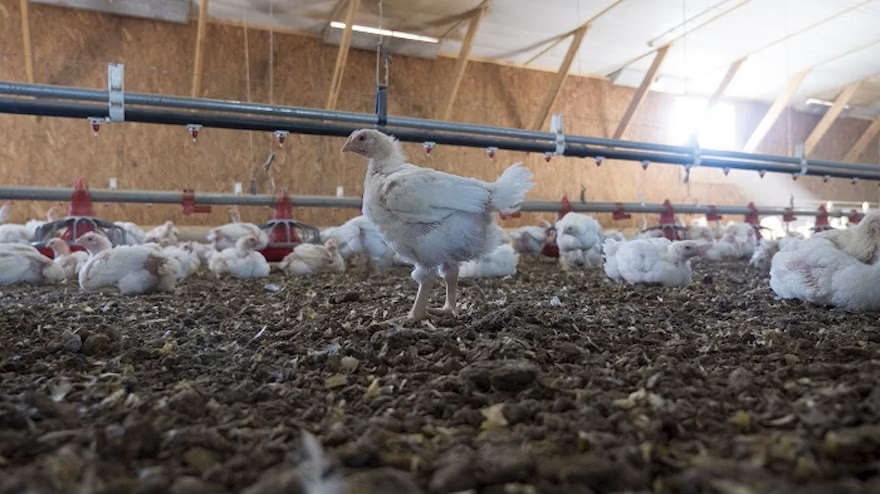
Benefits
- In equatorial regions, light from the sun is consistent from season to season
- Full spectrum light ranges from ultra-violet (UV) to infra-red (IR)
- Responses to sunlight changes from day to day and season to season and are naturally inherent in both domestic and wild fowls
- Poultry houses designed to utilize natural daylight may require little to no artificial light, thereby saving on energy costs
Shortcomings
- Spectral composition and intensity of sunlight changes from dawn to noon to dusk, from season to season, sunrise to sunset, with location, and with cloud cover.
- Light intensity will change throughout the day as light comes in from different areas of the house.
- Light intensity is much higher from the sun than from an artificial lamp and overcoming seasonal changes in day length can be difficult. A bright sunny day can be 60,000 to 100,000 lux (6,000 to 10,000 foot-candles (fc)).
- High light intensity may cause aberrant behaviors in poultry such as nervousness, feather pulling, pecking, and cannibalism.
Incandescent light
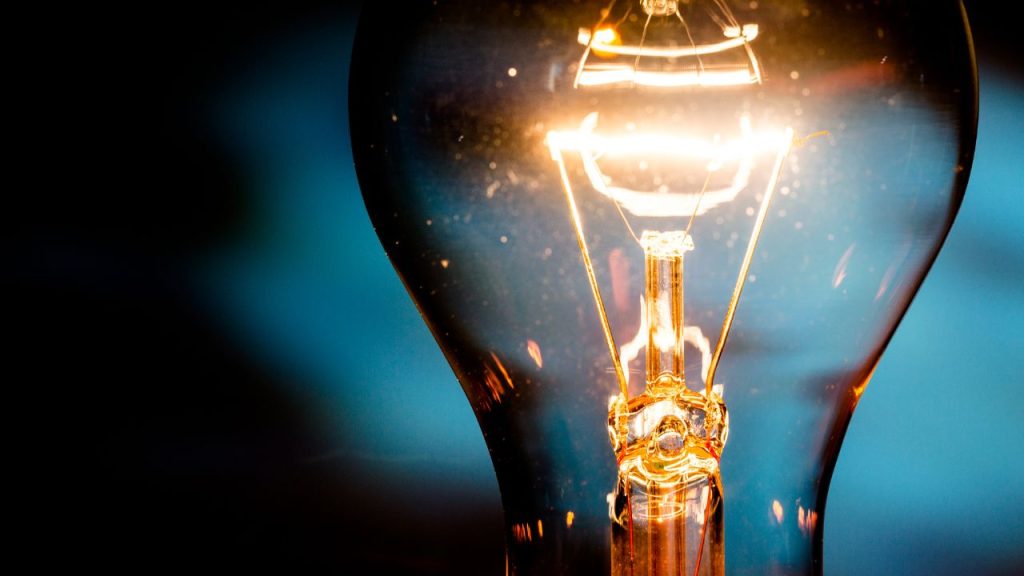
Benefits
- Inexpensive
- Good red spectrum output
- Excellent light distribution
- Quick to turn on
- No difference in performance when used in cold weather
Shortcomings
- Short lifespan and lamps must be frequently changed
- Usually constructed of metal and glass and are prone to breakage
- More than 90 percent of the energy used by the lamp goes to producing heat rather than light
- Many types of incandescent lamps do not comply with new energy efficiency standards
Compact fluorescent light (CFL)
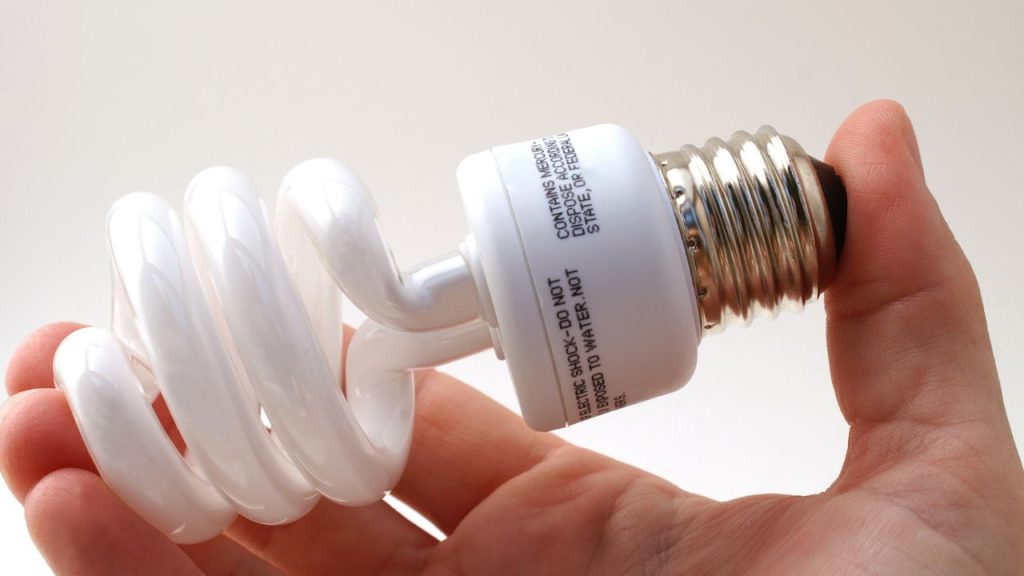
Benefits
- Energy efficient
- Relatively inexpensive
- Similar color spectra as incandescent bulbs
- Available in both warm and cool spectra (Kelvin rating)
- Proven success in layer, broiler and breeder poultry industries
Shortcomings
- Contain mercury
- Uncovered spiral tubes may be difficult to clean
- Made of metal and glass and are prone to breakage
- Lamps do not dim well, with potential to burn out more quickly when dimmed
- While appearing to be white light, CFLs are composed of light spectrum peaks depending on the color spectra phosphors utilized in the lamp
- Lamps require several minutes to reach maximum light intensity when turned on
- Poor performance in cold weather
- Not ideal in situations where light must be turned on and off multiple times per day
- Requires an electronic ballast to regulate current and voltage supplied to the lamp
Light emitting diode (LED)
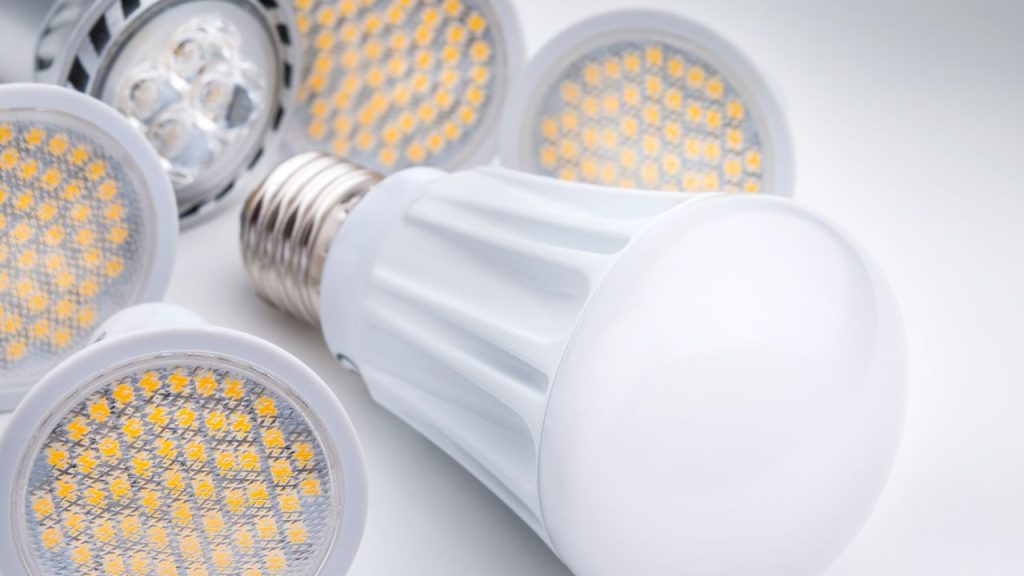
Benefits
- Provides a full spectrum of light
- Typically, the most efficient light lamp as measured in lumens per watt
- Because LEDs do not emit infrared radiation (heat), they can be constructed out of non-glass materials that are water resistant and shatterproof
- Typically manufactured from non-toxic materials
- Can be designed to focus light onto desired areas
- Colour spectrum of the light can be adjusted depending on the phosphors used
- Easier to dim than CFL lamps
- Dimming can extend a lamp’s lifespan
- Very long life – up to 10 years at 16 hours per day (50,000 to 60,000 hours)
- Rapidly reaches peak light intensity after being turned on
- Ideal for areas where lights are frequently turned on and off
- Efficient in cold weather with no change in performance
Shortcomings
- Expensive (although prices continue to decrease)
- Must use the proper dimmer, otherwise lamps may flicker and burn out more quickly
- LED light is directional and requires an appropriate lens to focus light, or appropriate diffusers to cover a broader area
- May need to change sockets and wiring to fit the ideal LED electrical specifications
- Efficiency of heat fins is reduced with dust buildup, poor ventilation around the lamp, or putting the lamp in a “jelly jar” for waterproofing
- Lights may not burn out after expected lifespan but may be dimmed greater than 70 percent of original lumen output. As a result, baseline lux testing in the animal or green house may be required to determine when lamps should be changed
- Cheaper LEDs may not have an appropriate heat sink, spectrum, hardware, or warranty for agricultural environments
LED-based lighting, the primary type of solid-state lighting today, is revolutionizing the lighting market (Stober et al., 2017). LED lighting has surged to the top above all conventional lighting technologies in terms of energy efficiency, life expectancy, versatility, and color quality. In addition, because of their increasing cost competitiveness, LED products are successfully competing in a variety of lighting applications. A U.S. Department of Energy (DOE) study forecasted that LED lighting will represent 86 percent of all lighting sales by 2035, resulting in an annual primary energy savings of 390 PJ (3.7 quadrillion British thermal units) (U.S. DOE, 2016).
Light quality affects production efficiency, animal welfare, and growth rate. The swine and dairy industries are increasingly recognizing the benefits of LED lighting. Also, the poultry industry has rapidly adopted LED lighting systems across all segments of the industry including layers, pullets, breeders, and broilers. The four main features associated with light are intensity, photoperiod, source, and spectrum (Manser, 1996). Color of light is determined by the various outputs from different wavelengths that make up the visible spectrum. White light contains all wavelengths of the visible spectrum, but it differs in color temperature (Kelvin rating) depending on the power emitted from different individual wavelengths within the spectrum.
However, despite remarkable energy savings offered by LEDs, there are things we must better understand such as dimming capabilities, compatibility with the light dimmer, wiring and socket quality, matching Kelvin rating to the need, and choosing the right LED. It’s not as simple as unscrewing an incandescent lamp and replacing it with an LED lamp.
Energy savings
As early as 2008, reports from the poultry industry appeared related to cost and energy savings associated with switching to more energy efficient lamps (Tabler et al., 2008). Dramatic reductions in energy use for lighting were observed at a University of Arkansas commercial 4-house broiler farm when 60-watt incandescent lamps were replaced with 23-watt dimmable CFLs and 8-watt dimmable cold cathode lamps (Table 1). A lighting cost savings of $520 per flock was also reported on the same 4-house farm (Table 1).
However, over time, the dimmable cold cathode and CFL lamps proved to be less durable under demanding poultry house conditions (Watkins et al., 2012). As a result, growers that switched to these technologies were soon reporting frequent lamp failures and loss of light intensity because of dirt accumulation on the spiral CFL designs. Challenges identified with using these lamps included lamp failures when lamps were dimmed below 10 percent and also due to incompatibility between lamps and the metal used in light sockets. Lamp failures were also reported in association with power surges related to operation of standby generators.
As an alternative, LEDs soon began to emerge as a potential lighting source for the poultry industry. LED lamps are more efficient, durable, versatile, and longer lasting than incandescent or fluorescent lamps. Light is produced by movement of electrons in a semiconductor material resulting in illumination of tiny light emitting diodes whereas incandescent lamps operate by passing electric current through a metal filament until it becomes so hot that it glows, producing both light and heat. LED lamps release only a small amount of heat into a heat sink above the diodes.
Savings associated with LED lamps are even more impressive than with other energy efficient alternatives. Energy savings associated with LED lamps to give the same amount of light are as much as 80 to 85 percent compared to incandescent lamps (Tabler et al., 2015) as proven multiple times in field trials across the U.S. poultry industry from Arkansas and Texas to the Delmarva Peninsula. A recent report from the U.S. Department of Energy (Lee et al., 2020) indicated major developments in indoor animal lighting that included the following:
- If all animal lighting today was converted to LED technology, annual lighting energy consumption for animal production would be reduced to 2.8 terawatt hours (TWh) of on-site electricity, which represents lighting energy savings of around 25 percent equating to $96 million
- The poultry industry has the largest total illuminated floor area, with 0.2 billion m2 for broilers and 0.1 billion m2 for layers. The hog industry has an estimated 77 million m2 and the dairy industry has an estimated 66 million m2.
- As of 2019, broiler farms had seen the highest adoption of LED lighting, at 58 percent. LED products made up 47 percent of lights in hog production, 36 percent in dairy farms, but only 26 percent for layers.
- As of 2019, lighting installations for animal production in the U.S. consumed 3.7 TWh of on-site electricity per year (Brumm, 2019) of which, 60 percent comes from lighting in dairy farms, 24 percent from broilers, and 7 percent each from lighting in poultry layers and hog facilities.
Energy savings associated with LEDs have never been in question. The question for the poultry industry has always been whether birds will perform as well under LEDs as they do under incandescent lamps. The answer is yes – if – light levels are adequate during brood and grow periods, light dimmers do their job correctly, and birds are cared for properly. Birds perform just as well under LEDs as under other typical light sources found in chicken houses. In the early days of LEDs in the poultry industry, most of the comparative work was done with broiler chickens. More recent work with pullets, layers, and broiler breeder flocks has since proven just as successful (Tabler et al., 2015).
Picking the correct Kelvin rating on the lamp is critical to flock performance. The layer, pullet, and broiler breeder segments of the poultry industry prefer a 2,700 to 3,000 Kelvin lamp because the orange/red in the color spectrum helps with achieving sexual maturity in the flock. The broiler segment prefers a 5,000 Kelvin lamp because the light blue color in the 5,000 Kelvin spectrum helps to keep broilers calm, increases weight gain, and reduces fear and stress level (Archer, 2017). Broilers are harvested before sexual maturity and, therefore, the orange/red part of the light spectrum is not as critical.
Regardless of Kelvin rating, it’s important that a poultry grower look closely at price, warranty, and designated use of the lighting system. All LEDs, regardless of price, can save significant amounts of energy that can translate into big monetary savings. However, it’s important to choose a lamp that has a track record in an agricultural environment such as a chicken house (Tabler et al., 2015). Omni-directional residential LEDs are not the best choice for such a setting because they direct too much light to the walls and ceiling; this light is wasted in a poultry house because the birds are on the floor.
A good choice of lamp should be competively priced, can withstand the harsh poultry house environment, is compatable with the light dimmer, and will deliver the light levels required. This is probably not the least expensive lamp on the market, but it need not be the most expensive lamp, either. Help is available to select the correct lamp for a particular operation from poultry intgerators, growers that have already switched to LEDs, and university/Extension personnel with LED lighting expertise.
Shifting from incandescent to LED lamps
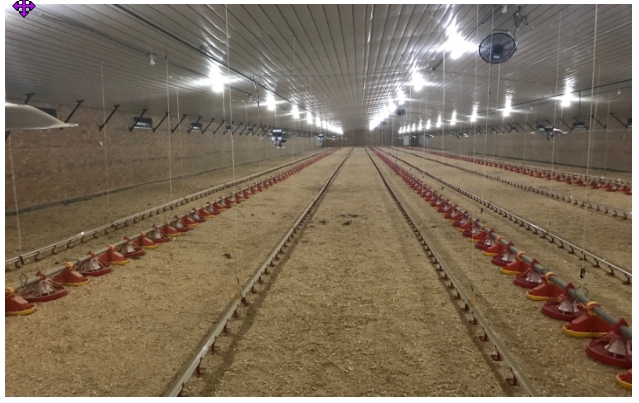
In less than a decade, the world has made a dramatic shift from incandescent lamps to dimmable LED lamps. Despite some growing pains, energy savings and long-life potential of LED technology made the frustration worth it. However, within the poultry industry, at least in the U.S.A., widespread problems with rapid lumen depreciation, erratic dimming performance, and premature total lamp failure have recently been reported on LED lamps that were only two to three years old; in many cases, this was several years before the warranty had expired (Tabler et al., 2020).
Most poultry houses in the U.S. are equipped with some version of a triode alternating current (TRIAC) light dimmer to adjust lighting levels as needed throughout the flock. A TRIAC is a small semiconductor device, similar to a diode or transistor. Resistors rapidly turn the light circuit off and on to reduce the total amount of energy flowing through the circuit. The lamp circuit is switched off many times per second. The switching cycle is built around typical alternating current (AC) that has varying voltage polarity in an undulating sine wave fluctuating from a positive to a negative voltage.
In the U.S., this alternating cycle happens 60 times per second, a frequency referred to as 60 Hertz, meaning the current changes direction (or “alternates”) 120 times per second, (equivalent to 60 cycles). A light dimmer interrupts the sine wave depending upon the dimmer setting. It automatically shuts the light circuit off every time current changes direction. This happens twice per cycle (120 times per second). It will turn the light circuit back on when voltage reaches a certain point. This “turn-on point” is based on where the dimmer switch is set (Tabler et al., 2019).
If the dimmer switch is turned to a brighter setting, the cut-on point is relatively soon after the cut-off point. Therefore, the circuit is on for most of the cycle and the overall light level remains bright. However, if the dimmer is set for a low light level, the cut-on point is later in the cycle and the circuit is off for much of the cycle, keeping the light level relatively dim. This is ideal for incandescent lighting because the tungsten filament in incandescent lamps is slow to heat up and cool down and the human eye sees light output as a constant level of decreased brightness.
Issues with light dimmers
Lighting programs are common practice on modern poultry farms to improve bird performance and meet welfare criteria (Tabler et al., 2019). An important aspect to consider today is the difference between omni-directional and directional LED lamps. Omni-directional lamps are not ideal in a chicken house because they send roughly 35 to 40 percent of their light either out or up. However, since the chickens are on the floor, most of the light needs to go down to the floor, not to the walls or ceiling, regardless of whether lights are dimmed or not.
To have a better understanding of dimming issues, it’s important to become familiar with a few lighting terms. When considering LEDs, it is important to understand information on the box and on the lamp. This information may include:
- Lumens – the amount of light output from a lamp (brightness)
- Watts – the amount of energy required to create the light output (power demand)
- Dimmable or non-dimmable
- Average rated life – that for a non-LED lamp is the typical time it takes for 50 percent of lamps to fail. For LEDs, usable life is the point in time when LEDs produce only 70 percent of their initial light output.
- Color Rendering Index (CRI) is a measure of the accuracy of the color perceived under the light of the lamp as compared to color perceived under natural daylight. A lower CRI value indicates that some colors may appear unnatural when illuminated by the lamp, with a CRI of 100 representing the maximum value. For poultry applications, LEDs should have a CRI of 80 or greater.
- Kelvin (K) – color or appearance of the light that the lamp emits. Warm/soft white light (similar to incandescent light) has a range of 2,700 – 3,000 K. Natural white light has a range of 3,000 – 4,500 K and cool white light has a range of 4,500 – 6,500 K. Broilers today are often grown under 5,000 K lamps while layers, pullets, and broiler breeders are more likely grown under 2,700 – 3,000 K lamps.
There are two main dimming methods used to interrupt or “chop” the AC sine wave that controls the light level (Tabler et al., 2020).
- Leading edge dimming –utilizes a current that is turned off as the AC sine wave begins, just after it crosses zero into positive territory. It cuts the front edge of each wave’s half cycle. Leading edge dimming creates a rush of voltage every half cycle, resulting in a rush of current to the light source. Leading edge dimmers can produce spikes in current that can cause increased stress to electronic drivers (Liao, 2014). Most LED chip manufacturers have indicated that exposure to current greater than 300 mA (milliamperes) will cause irreversible damage to the chips.
Leading edge dimmer switches are simpler, less expensive, and more common than trailing edge dimmers. They typically use a TRIAC switch to control power. TRIAC dimmers, used since around 1960, were originally designed to dim incandescent and halogen lamps and wire-wound magnetic transformers. Many leading-edge dimmer switches have a high minimum load, which limits their use with modest-load LED circuits. This explains why it is sometimes necessary to put an incandescent lamp at the end of the line to help the dimmer find enough load to properly do its job.
- Trailing edge dimming – Trailing edge dimming utilizes a current that turns off as the AC sine wave ends, with dimmers designed specifically for use with low-wattage LED lamps. Trailing edge dimmers often use a metal oxide semiconductor field effect transistor (MOSFET) or insulated gate bipolar transistor (IGBT) switch (ERP Power, 2016). Trailing edge dimmers have a lower minimum load and are more suitable for powering modest-wattage LED lamps. They avoid current spikes by switching the light phase circuit on just as the current changes direction, allowing the voltage to rise gradually before turning it off later in the half cycle.
Determining proper light level in a broiler house is difficult without a light meter. Many service technicians now carry light meters. LED light meters can be purchased for less than $150. Light measurements should be taken at bird level at various locations (directly under a lamp, between lamps, at wall, etc.) to determine light levels in the house. Different light dimmers often dim differently because of how the lighting curve in the dimmer responds. As a result, light levels may be different between houses even though the dimmers may all be set at the same dimming level, making a light meter a critical piece of equipment.
Issues often occur in certain low end lighting situations such as found in today’s broiler houses. In these situations, very low light output is required when the dimmer is set at a low level. However, the lamp’s dimming performance depends on how well the dimming range of the dimmer matches the dimming range of the drivers in the LED lamp. Problems occur when the two do not closely match. Unfortunately, despite the fact that LED lamps must be compatible with phase dimmers, there is no industry standard that defines characteristics of light dimmers on the market today. Therefore, we are seeing compatibility issues between the variety of dimmers on the market and the multitude of LED lamps on the market. As a result, we may see one brand of dimmer work with one brand of LED lamp but not work with another.
As a general rule, only trailing edge dimmers should be used with any dimmable LED lamp. Because leading edge dimmers cut the front edge of each AC sine wave’s half cycle, a huge inrush of current flows through the lamp’s circuitry, eventually damaging the electronic drivers and LED chips, leading to premature lamp failure. Trailing edge dimmers, on the other hand, cut the back half of the AC sine wave where the output voltage rises relatively slowly and avoids the huge current spikes that leading edge dimmers send into capacitive load LEDs, thereby reducing stress on the electronic drivers and LED chips and extending lamp life.
What does this all mean for the chicken grower, integrator, and lamp and dimmer distributor? Perhaps most important, if you are using LED lamps in the chicken house, you should be using a trailing edge dimmer to dim those lamps. If you aren’t, expect problems. If your dimmer has both leading edge and trailing edge capabilities, be extra cautious that someone (you, your service tech, the catch crew, etc.) does not switch the dimmer to a leading edge channel and then fail to switch it back. Preferably, use directional LED lamps with an agricultural rating that are designed for chicken house applications.
If you are using Omni-directional LED lamps with a smaller heat sink and lesser craftsmanship in a chicken house, expect problems. We can’t haphazardly throw together a hodgepodge of lamps and dimmers and expect not to have issues. Unknowingly however, that is exactly what we have done. And until we take the necessary actions to correct those missteps, lamp failures will continue. If the right LED lamp is used in combination with the right light dimmer, many of the issues currently being experienced with premature lamp failures and erratic dimming behavior should go away. Any combination of lamps and dimmer that delivers improper lighting and dimming is only cheating the chickens (Tabler et al., 2021). Cheating the chickens comes with a price that always seems to be reflected on the settlement sheet.
References
Archer, G. S. 2016. Comparison of raising broilers under light emitting diode or incandescent light at differing intensities on growth, fear and stress, Int. J. Poult. Sci. 15:425-431.
Archer, G. S. 2017. Color temperature of light-emitting diode lighting matters for optimum growth and welfare of broiler chickens, Animal 12(5):1015-1021.
Brumm, M. C. 2019. Space allocation decisions for nursery and grow-finish facilities, eXtension, Available at: https://swine.extension.org/space-allocation-decisions-for-nursery-and-grow-finish-facilities/. (Accessed: 14 June 2021).
Hy-Line International. 2017. Understanding poultry lighting: A guide to LED bulbs and other sources of light for egg producers, Hy-Line International, Technical Update.
Lee, K., C. Elliott, and M. Pattison. 2020. Energy savings potential of SSL in agricultural applications, U. S. Department of Energy, Office of Energy Efficiency & Renewable Energy. June. Available at: https://www.energy.gov/sites/prod/files/2020/07/f76/ssl-agriculture-jun2020.pdf. (Accessed: 15 June 2021).
Liao, A. 2014. LEDs: A deep dive in dimming, Architectural Lighting. Available at: (https://www.archlighting.com/technology/leds-a-deep-dive-in-dimming_o). (Accessed: 16 June 2021).
Manser, C. 1996. Effects of lighting on the welfare of domestic poultry: A review, Anim. Welf. 5:341-360.
Sands, R., P. Westcott, J. M. Price, et al. 2011. Impacts of Higher Energy Prices on Agriculture and Rural Economies, ERR-123, U. S. Dept. of Agriculture, Econ. Res. Serv., August. Available at: https://www.ers.usda.gov/webdocs/publications/44894/6814_err123_1_.pdf?v=41432. (Accessed: 14 June 2021).
Stober, K., K. Lee, M. Yamada, et al. 2017. Energy savings potential of SSL in horticultural applications, U. S. Department of Energy, Office of Energy Efficiency & Renewable Energy, December. Available at: https://www.energy.gov/sites/prod/files/2017/12/f46/ssl_horticulture_dec2017.pdf. (Accessed: 15 June 2021).
Tabler, G. T, S. E. Watkins, and P. A. Watkins. 2008. Energy efficiency associated with poultry house lighting, Avian Advice 10(3):1-3.
Tabler, T., M. Farnell, and J. Wells. 2015. LED Bulbs: Much to offer the poultry industry, Mississippi State University Extension Service, Publ No. 2894, July.
Tabler, T., J. Moon, and J. Wells. 2019. Why poultry growers have issues dimming LED lamps, Mississippi State University Extension Service, Publ No. 3380, August.
Tabler, T., J. Moon, and J. Wells. 2020. Issues with poultry house LED lamps and light dimmers, Mississippi State University Extension Service, Publ No. 3510, August.
Tabler, T., J. Wells, and J. Moon. 2021. Broiler house lamp and light dimmer basics. Mississippi State University Extension Service, Publ No. 3639, June.
U.S. Department of Energy Solid State Lighting Program. 2016. Energy savings forecast of solid-state lighting in general illumination applications, U.S. Department of Energy, Prepared by Nagivant Consulting. August. Available at: